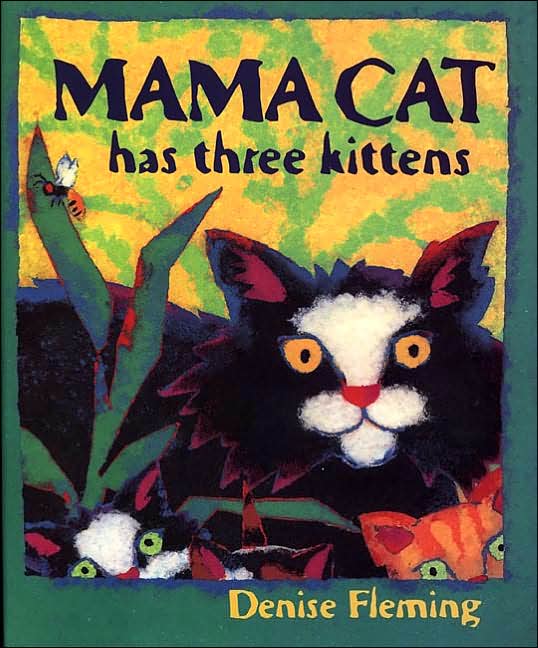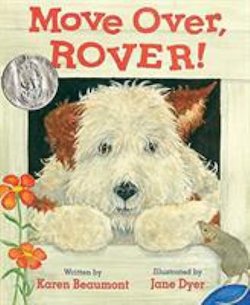Storytelling and Props:[This story with props is based on a wordless picture book, now out of print. Elephant Buttons begins with a picture of an elephant, but the elephant has buttons on his belly; on the next page we realize that this is not actually an elephant, but a lion dressed up as an elephant. But wait! The lion has buttons too. Who is it in the lion costume? And so, each page reveals yet another animal in a costume with buttons in order after the lion there is a horse, then a duck, and then a mouse all with buttons. When we open the buttons of the mouse, there is an elephant with no buttons.]
The attached document give the pattern and instructions. elebuttons
Our next story Elephant Buttons by Noriko Ueno is quite an interesting one. I am going to tell it to you using some props. Let's see what you think is happening as I tell this story.
Begin by holding up the elephant piece that has buttons on his tummy. What’s this? An elephant? Right! But what’s this on his tummy? Buttons? Do elephants have buttons on their tummies? No? What do you think will happen if we unbutton the buttons?
Unbutton the buttons and reach inside and pull out a lion, with buttons on his tummy. And the questions continue. Proceed with a horse, a duck, and a mouse, all with buttons on their tummies. Unbuttoning the mouse reveals a big elephant with no buttons on his tummy! If the elephant is too big to actually fold into the mouse, then hold it hidden in the palm of your hand and pull it out at the appropriate time. Discuss why an elephant would dress up in a mouse costume inside a duck costume inside a horse costume, and so on.
Early Literacy Aside--Example: Using stories that can be interpreted in different ways offers your children an opportunity to think and offer their opinions. It allows them to look at what is happening from different perspectives. By asking open-ended questions and encouraging children to talk, asking what they are thinking, we give them a chance to problem-solve and to express what they are thinking, both are skills that will help them later understand what they read.
Amy Alapati, Montgomery County (MD) Public Libraries



 Cat Puppet: There's a cat in my hat, a cat in my hat, a cat in my hat today (do twice). What does the kitty cat say? [cat puppet says meow]Read Mama Cat Has Three Kittens
Early Literacy Aside--Example: When children hear rhymes, rhythms and sounds of animals, it helps them develop phonological awareness, hearing the smaller sounds in words. This is a skill that will help them as they begin to read.
Early Literacy Aside--Empower: Keep doing rhymes with things in your children's world. Today we did cat in my hat. You can do ball in the hall or star on my car (give a star sticker).
Cat Puppet: There's a cat in my hat, a cat in my hat, a cat in my hat today (do twice). What does the kitty cat say? [cat puppet says meow]Read Mama Cat Has Three Kittens
Early Literacy Aside--Example: When children hear rhymes, rhythms and sounds of animals, it helps them develop phonological awareness, hearing the smaller sounds in words. This is a skill that will help them as they begin to read.
Early Literacy Aside--Empower: Keep doing rhymes with things in your children's world. Today we did cat in my hat. You can do ball in the hall or star on my car (give a star sticker).
 Before reading the book: Ask the children to describe things they would put in a box. And in this box it will contain art supplies. What can you think of? They reply with crayons, paint, etc. This is a great way for children to use the vocabulary that they do know and also good for developing Narrative Skills, which is the ability to describe events and tell stories. Now let's see how a book can help introduce children to new vocabulary.Read the book Art Box by Gail Gibbons.
Have items like compass, protractor, etc. available for the children to see and use. Talk about what they do.
Early Literacy Aside--Empower: Parents, having real objects to help children understand words in the book is one way to help build their vocabulary, to learn the meanings of words. Even when you are not reading books, just talking about objects around the house and what they do is one way to expand children's understanding.
Before reading the book: Ask the children to describe things they would put in a box. And in this box it will contain art supplies. What can you think of? They reply with crayons, paint, etc. This is a great way for children to use the vocabulary that they do know and also good for developing Narrative Skills, which is the ability to describe events and tell stories. Now let's see how a book can help introduce children to new vocabulary.Read the book Art Box by Gail Gibbons.
Have items like compass, protractor, etc. available for the children to see and use. Talk about what they do.
Early Literacy Aside--Empower: Parents, having real objects to help children understand words in the book is one way to help build their vocabulary, to learn the meanings of words. Even when you are not reading books, just talking about objects around the house and what they do is one way to expand children's understanding.

